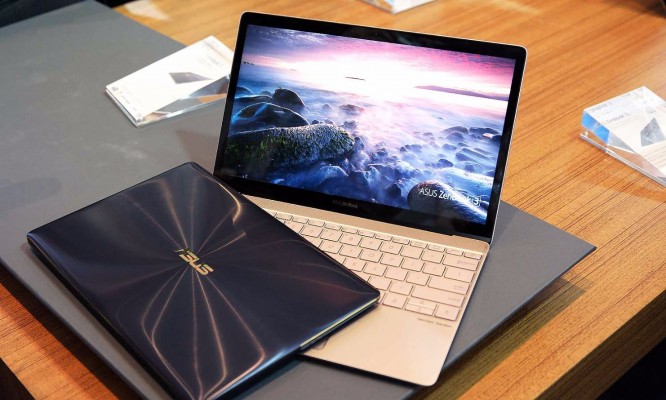Asus ZenBook 3 Packs Core i7 CPU in MacBook-Size Body
Ultrathin laptops with a handful of USB Type-C ports are all the rage in 2016. Earlier this spring, Apple refreshed its MacBook 12-inch while HP rolled out its even-thinner EliteBook Folio G1 and announced the slimmer-still Spectre. Now, Asus is getting into the game with the ZenBook 3, a 0.47-inch thick, 2-pound laptop that promises to overpower its competitors with an optional Core i7 CPU and speedy PCIe x4 SSD. Starting at $999, for a Core i5 model and scaling up to a $1,999 config with a 1TB PCIe SSD, the snazzy new Asus system could be the "most prestigious laptop ever."
I had a chance to spend a few moments with the ZenBook 3 at Asus's Computex 2016 press conference and came away impressed with its snappy keyboard, colorful chassis options and vibrant display. It almost goes without saying that Asus's laptop feels light in the hand. At 2.01 pounds, it's noticeably svelter than both the 2.14-pound EliteBook Folio G1 and about on a par with the 2.03-pound MacBook. The 0.47-inch thin chassis is a bit slimmer than the MacBook's 0.52-inch thickest point, though Apple's laptop tapers down to 0.14 inches. The EliteBook Folio G1 is the same 0.47 inches thick.
The ZenBook 3 is available in three different colors: Royal Blue, Rose Gold and Quartz Gray. I was particularly impressed with the Royal Blue model, because it looks so different than HP and Apple's offerings, in a good way. Asus says that the laptop is made from "aerospace-grade aluminum alloy," which it claims is 50-percent stronger than standard aluminum alloy.
Unlike the EliteBook Folio and MacBook, which sport low-power Core M CPUs, the ZenBook uses a full-fledged Core i7 or Core i5 processor. To accommodate the faster, hotter-running chip, Asus packs in a super-slim fan. The upcoming HP Spectre also offers a Core i5 or i7 processor in its 0.4-inch thick, body.
MORE: Best Asus Laptops
Asus claims that, despite its small size and relatively power-hungry CPU, the ZenBook 3 will last up to 9 hours on a charge. We'll have to see how it fares on the Laptop Mag Battery test, which involves continuous surfing over Wi-Fi. On our benchmark, a Core m7-powered EliteBook Folio managed just 7 hours and 2 minutes while a Core m5-enabled MacBook endured for 9 hours and 38 minutes.
Unfortunately, just like the MacBook, Asus's laptop has only one USB Type-C port for both charging and data, along with a 3.5mm headphone jack. HP one-ups both Asus and Apple by offering two USB Type-C ports on the EliteBook Folio and three on the Spectre.
Sign up to receive The Snapshot, a free special dispatch from Laptop Mag, in your inbox.
Asus boasts that its keyboard has 0.8mm of travel, which is more than the MacBook's measly 0.5mm. While I didn't have a ruler to measure its depth, the keyboard definitely felt much deeper and snappier than Apple's. However, the EliteBook Folio G1's keys have an even-deeper 1.05mm of travel and offer even better tactile feedback.
The ZenBook 3's 12.5-inch, 1920 x 1080 glossy display really popped on the display models I saw. A desktop wallpaper picture of the sun settingon some rocks looked particularly rich and vibrant. Asus claims that the display can cover 72 percent fo the NTSC color gamut, which is pretty good. In our lab, we measure laptop screens against the less-demanding sRGB gamut so we look forward to seeing how the Zenbook 3 fares when we're able to test it with our colorimeter. The screen bezel is really thin, but doesn't quite match up to the nearly bezel-free Infinity Display on the Dell XPS 13.
Asus will sell the ZenBook 3 in three configurations. The $999 base model will have a Core i5 CPU, 4GB of RAM and a 256GB SSD. A $1,499 model will include a Core i7 CPU, 16GB of RAM and a 512GB SSD. The high-end, $1,999 model doubles the storage to 1TB. Asus has not announced a U.S. shipping date, but whenever it arrives, we look forward to putting the ZenBook 3 through its paces.





